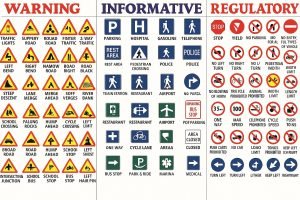Introduction

Road signs are the “language of the road.” They guide, warn, and regulate drivers so everyone can travel safely. While colors and shapes help you recognize signs quickly, it’s also important to know the three main types of road signs and what each category means.
1. Regulatory Signs – Rules You Must Follow
-
Purpose: Tell drivers what they must do or must not do under the law.
-
Colors: Usually red, white, or black.
-
Shapes: Often vertical rectangles or special shapes (STOP = octagon, YIELD = triangle).
-
Examples:
-
STOP
-
YIELD
-
Speed Limit
-
No U-Turn
-
Do Not Enter
-
One Way
-
2. Warning Signs – Alert You to Hazards Ahead
-
Purpose: Warn drivers about conditions on or near the road.
-
Colors: Usually yellow or fluorescent yellow-green; orange for construction.
-
Shapes: Most are diamond-shaped.
-
Examples:
-
Curve Ahead
-
School Zone or School Crossing
-
Slippery When Wet
-
Deer Crossing
-
Merge Ahead
-
Road Work Ahead
-
3. Guide Signs – Provide Directions and Information
-
Purpose: Help drivers find their way and access services.
-
Colors: Green (directions), blue (services), brown (parks & recreation).
-
Shapes: Usually horizontal rectangles.
-
Examples:
-
Highway Exits
-
Distance/Route Signs
-
Hospital Ahead
-
Gas/Food/Lodging
-
National Park Signs
-
Safety Tip
If you can instantly recognize a sign’s category (Regulatory, Warning, or Guide), you can react quickly — even before you read the words.
Conclusion
Every traffic sign you encounter will fit into one of three categories:
-
Regulatory = Laws
-
Warning = Hazards
-
Guide = Directions & Services
Learning to identify these categories by color, shape, and symbol will make you a confident and safe driver.
